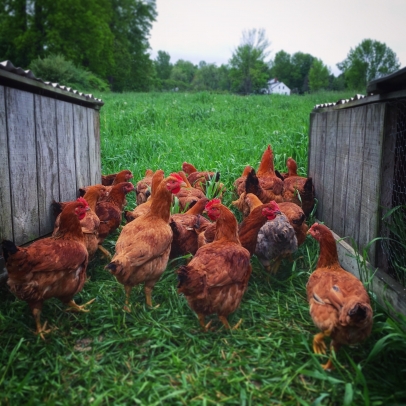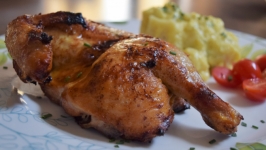Rethinking Chicken
“A chicken in every pot.” It’s a slogan that’s entered our national lexicon, a folksy shorthand for populist prosperity. The phrase has lodged in our American consciousness for a reason. Attributed to a campaign pamphlet for Herbert Hoover’s 1928 presidential campaign (echoing a similar decree from 17th century French monarch Henry IV), “a chicken in every pot” was a promise of general affluence for society. It may not sound like much now, but in its day, the idea of abundant chicken – enough to eat every week, let alone every day – would have seemed positively extravagant.
In that era, chicken wasn’t readily available, and when it was, it wasn’t the cheap filler it’s since become. The sort of chickens commonly raised in early 20th century America were egg-layers, and they would have been far more valuable as steady egg producers than one-time dinners. Most chickens destined for the table would have been roosters or older laying hens past their prime, both of which would have been fairly tough and lacking the physical proportions we’ve come to know in today’s birds. There’s a reason the chickens were promised in “every pot” and not in every roasting tray; stewing or braising would have been the traditional way of preparing them to soften the tough birds and stretch one meal into several. Cockerels, capons (castrated roosters), and larger eating varieties all took substantial time or investment to raise, and since doing so on a large scale was virtually unheard of, chicken was a quasi-luxury. The promise of enough societal affluence to make regular Sunday dinner chickens possible was enough to win Hoover the presidency.
Over the course of the 20th century, Hoover’s campaign promise came to startling fruition. Hybridization programs produced fast-growing breeds that were raised expressly for meat, most notably the now-omnipresent Cornish-Rock Cross. The Cornish Cross was a chunky white chicken with double-layered breast meat and an unusually swift rate of growth. It quickly became the chicken of choice for poultry growers across the country.
Soon, other factors – such as the exodus of the rural workforce to urban settings, the growth of transcontinental infrastructure, and the development of cheap antibiotics – led the nascent meat-bird business to rapidly industrialize. Raising birds in confinement saved on labor, interstate trucking made local markets obsolete, and antibiotics allowed for living conditions that would otherwise prove fatal while simultaneously promoting growth. Instead of the Sunday dinner chicken coming from the neighboring farm’s flock, it was soon coming from massive brooding sheds along the Atlantic seaboard or in the Midwest. Tens of thousands of chickens could be housed together, raised to market weight in a matter of a few weeks, processed, flash frozen, and shipped to every grocery store in the country.
Raising so many birds in confinement produced massive amounts of waste. Waterways in chicken producing regions soon became some of the worst polluted in the nation. The Chesapeake Bay struggles even now with massive influxes of poultry effluvia every time it rains upstream. And since the actual raising of the birds was the riskiest and least profitable aspect of the chicken industry, many of the larger corporations got out of that business all together. They would contract with growers to raise birds for them. The growers bore the risk and the cost, and because they were, in effect, independent contractors, there was little they could do to determine how they were compensated. As bad as conditions were for the growers, the situation in the slaughterhouses was even grimmer. Dangerous and odious working conditions and low wages soon drove away most American line workers, and companies turned increasingly to immigrant and refugee labor, particularly undocumented Central Americans. These workers had few other employment options and little recourse in event of a dispute or accident, of which there were many.
Perhaps the worst facet of the chicken industry, however, was the fate of the chickens themselves. The hybridization of the industry-standard meat bird continued trending towards rapid growth and feed efficiency to the detriment of everything else. The birds grew so large so fast that natural breeding became a physical impossibility. Medical problems became rife, and mortality could be high, as the birds would literally eat themselves into immobility and death. Cardiac and musculoskeletal afflictions were a constant threat. If they weren’t slaughtered at a young age, their leg bones could eventually break under their own weight. They were housed by the thousands in vast, barn-like structures, with only enough room to reach the nearest feed or water dispenser. Fecal dust and feather dander would fill the air, even with ventilation units operating full time. Crowded in such teeming numbers, the only way to control endemic disease was with a steady diet of antibiotics, administered as a routine preventative measure. In the heat of summer, a malfunctioning exhaust fan or water line could kill tens of thousands of birds in an afternoon. The only glimpse of sun or breath of fresh air most birds would ever receive would come while in a crate, in transit to the slaughterhouse, from which they would emerge as wings, tenders, “fingers,” drumsticks, and a variety of chicken-esque bits and pieces.
All of which is merely preamble to ask: was it worth it? In America today, chicken has a become a ubiquitous food-stuff almost entirely divorced from the nature of the bird it once was. Fried chicken sandwiches are popular menu items at many fast-food chains. Wings, once industry ejecta, now appear slathered in buffalo sauce in restaurants everywhere. Finely ground chicken is extruded into stars, hearts, dinosaurs, and other fun shapes and marketed to kids in nugget form. Everywhere across the country, burritos and fried rice and Caesar salads are all bulked out with the addition of the pervasive protein. “With chicken” has become the new normal, the base line by which the rest of the menu offerings are judged. But it all tastes forgettable.
“Tastes like chicken” is a punch line, because chicken, as we know it today, doesn’t taste like much at all. We slather it in barbeque sauce, we crisp it in fryer grease, we do anything possible do disguise it until it’s past our palate and in our stomachs. Without help, the flavor descriptor most associated with industrial chicken is “bland,” and adjectives for texture run the gamut from “rubbery” to “not unlike cardboard.” Eating chicken has become both habitual and joyless.
When we eat industrialized chicken, we’re purposefully ignoring the costs. The chicken industry can be brutal on anyone below the level of middle management. The growers are often shackled to disadvantageous contracts, the slaughterhouse workers are routinely exploited, and the chickens themselves lead brief and squalid lives. The typical industry retort is that they are feeding the nation and the world, as if every culture, prior to a century or so ago, couldn’t make better-tasting food with less. We don’t need industrial chicken, and we barely even want it; we’re merely accustomed to it.
But there’s a reason chicken was so desirable in the first place: good chicken is absolutely delicious. A whole roasted chicken with crispy skin, rich dark meat, and a simple au jus is a thing of beauty to any ethical omnivore. It’s not an everyday item, and it shouldn’t be. Raising a chicken well takes time and effort, and here in the northeast it’s a seasonal endeavor. There are breeds new and old, like the hybrid Freedom Ranger or heritage Delaware, that both taste better than their industrial counterparts and behave like proper chickens should. These are breeds that, while slower growing than Cornish Cross, thrive in a pasture-based farming model. Raised in smaller batches, outdoors on grass, the need for antibiotics vanishes. The chickens have freedom to forage and exercise, and their manure is spread beneficially on fields rather than accumulating into an environmental hazard. Local farm-raised birds are often slaughtered in smaller, regional processing plants staffed by owner-operators or, better still, slaughtered on-farm by the men and women who put time and effort into raising them properly. The price of a farm-fresh bird will certainly exceed anything in the supermarket, but those dollars will stay in the community rather than going into distant pockets.
It takes more care, and it takes more labor, and the chickens cost more money, but the result is well worth it. A roast chicken becomes a meal to look forward to, to savor, to come together with friends and family over. And then, used ethically, that chicken will stretch into leftovers or soup or stock. Rather than a culinary afterthought, a well-raised chicken can become the gastronomic high point of an entire week. It’s time to re-think chicken, to approach the humble bird with pleasure and mindfulness and, above all, gratitude, and to once again make chicken the small but unifying luxury that all Americans once understood tasted like prosperity.









